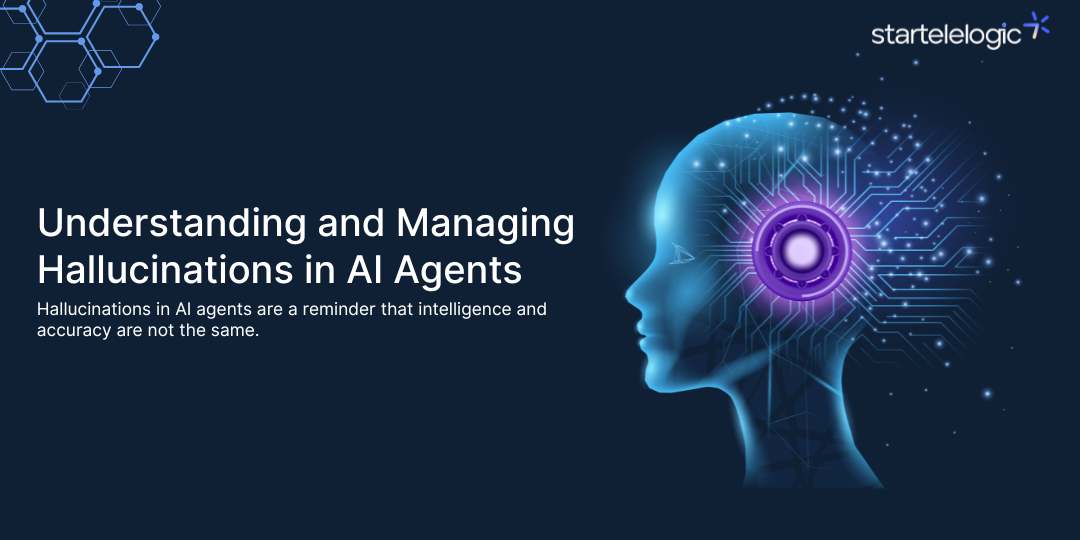Artificial Intelligence (AI) agents are becoming a familiar part of modern life. We talk to them when we use virtual assistants like Siri or Alexa, get help from chatbots on websites, or receive movie or product suggestions online. These systems are designed to make our lives easier by processing information and providing quick answers.
However, even with all their impressive abilities, AI agents can sometimes make mistakes that seem strange or unexpected. One of the most common problems is something experts call “hallucination.” This happens when an AI gives a response that sounds confident and logical but is actually false or made up. Learning how to manage hallucinations in AI agents is becoming an important focus for researchers, developers, and everyday users who depend on these tools.
What Exactly Are AI Hallucinations?
When an AI “hallucinates,” it doesn’t mean it’s imagining things the way humans do. Instead, it means the AI generates incorrect or fictional information while trying to respond to a question. For example, it might:
- Invent facts that don’t exist.
- Attribute false quotes to real people.
- Mix up details from different sources.
- Create references or links that lead nowhere.
This can be confusing, especially because AI agents usually write or speak in a very confident and natural tone. A user might easily believe the response is true, which can lead to misinformation or errors in decision-making.
Why Do AI Agents Hallucinate?
To understand how to manage hallucinations in AI agents, it’s first helpful to know why they happen. AI systems don’t think or understand the world like humans. They don’t have awareness or judgment — they generate text based on patterns they’ve learned from huge amounts of data. Here are the main reasons hallucinations occur:
- Limited or biased training data:
AI models learn from examples in the data they are trained on. If that data contains mistakes, outdated facts, or biases, the AI will naturally repeat or expand upon them. - Pressure to provide an answer:
Many AI systems are designed to always respond, even if the question is confusing or outside their knowledge. Instead of saying “I don’t know,” they often make educated guesses that sound believable. - Lack of real-world understanding:
AI agents don’t actually “know” facts. They predict what words are likely to come next based on previous patterns. This makes it easy for them to produce text that looks right but isn’t. - Complex or vague user input:
When a user asks a question that’s unclear or overly broad, the AI might try to fill in the gaps by creating details to make the answer sound complete. - Old or static information:
Some AI systems are trained once and not updated frequently. Without new data, they may give outdated or incorrect answers.
Why Managing Hallucinations Matters
Hallucinations might seem harmless at first — just small mistakes. But they can cause real problems if people rely on AI for important decisions. For example:
- A student might use an AI writing assistant that cites fake sources.
- A company might make a business decision based on false data generated by an AI report.
- A medical chatbot could share misleading health advice.
In each case, the issue comes down to trust. If users can’t trust what AI agents say, their usefulness decreases. That’s why finding ways to reduce or control hallucinations is so important.
How to Manage Hallucinations in AI Agents
Developers, researchers, and even users can play a role in reducing hallucinations. Here are some practical steps and methods being used today to make AI agents more reliable:
- Train with accurate and diverse data:
Using well-reviewed, up-to-date, and varied data sources helps AI models form a more balanced understanding of the world. - Integrate fact-checking tools:
Some AI systems now include fact-checking mechanisms that verify information against trusted databases before giving an answer. - Allow AI to admit uncertainty:
Instead of forcing the AI to always produce an answer, it’s better to design systems that can say, “I’m not sure” or “I don’t have enough information.” - Human review and feedback:
Having human experts check AI responses — especially in sensitive fields like health, finance, or education — greatly reduces the risk of errors. - Clear and specific user input:
Users can help by asking detailed, clear questions. The more context an AI has, the less likely it is to invent or assume information. - Continuous model updates:
Regularly retraining and improving AI models ensures they stay current and less prone to repeating outdated or incorrect information. - Transparency and user education:
Educating users about the limitations of AI helps manage expectations. When people know that AI can sometimes make mistakes, they’re more likely to double-check information.
The Future of Reliable AI Agents
As AI technology continues to advance, reducing hallucinations is becoming one of the main goals for developers and researchers. Future systems are expected to combine the creativity and fluency of current AI models with better fact-checking and reasoning skills.
Imagine AI agents that can cross-check their own answers in real time, verify facts from trusted sources, and provide clear explanations of where their information came from. This level of transparency and accuracy would make AI a far more dependable partner in education, business, healthcare, and daily life.
The journey toward completely trustworthy AI is ongoing, but understanding how to manage hallucinations in AI agents is a vital step in the right direction. By building systems that value truth, clarity, and reliability, we can ensure that artificial intelligence becomes a tool that truly supports human progress.
FAQs on Understanding and Managing Hallucinations in AI Agents
1. What does “hallucination” mean in AI agents?
A hallucination in AI agents happens when the system produces information that sounds correct but is actually false or made up. It occurs because AI models predict patterns in language rather than truly understanding facts.
2. Why do AI agents create false or misleading information?
AI agents sometimes generate false information because of limited or biased training data, unclear prompts, or the system’s built-in tendency to always give an answer — even when unsure. This is one of the main challenges researchers address when exploring how to manage hallucinations in AI agents.
3. How to manage hallucinations in AI agents effectively?
To manage hallucinations in AI agents, developers can train models on reliable data, include fact-checking tools, allow the system to express uncertainty, and use human oversight to verify critical outputs. These steps make AI more accurate and trustworthy.
4. Can hallucinations in AI agents be completely eliminated?
At present, hallucinations can’t be fully eliminated, but they can be greatly reduced. Continuous training, improved data quality, and grounding AI systems in verified information are key parts of how to manage hallucinations in AI agents effectively.
5. How can users identify hallucinations in AI responses?
Users can spot hallucinations by double-checking facts, noticing overconfident or highly specific details, and verifying any claims or references provided by the AI. Understanding how to manage hallucinations in AI agents also includes knowing how to recognize when an AI might be wrong.
6. Why is it important to manage hallucinations in AI agents?
Managing hallucinations in AI agents is vital because false or misleading information can harm decision-making, research, and public trust. By learning how to manage hallucinations in AI agents, developers and users can make AI systems more dependable and beneficial for everyone.



